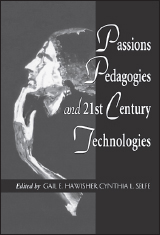James Sosnoski, Hyper-Readers and Their Reading Engines

Hyper-Readers and Their Reading Engines
JAMES SOSNOSKI

Sosnoski, James. “Hyper-Readers and Their Reading Engines.” Passions, Pedagogies, and 21st Century Technologies. Ed. Gail Hawisher and Cynthia Selfe. Logan, UT: Utah State UP, 1999. 161–77. Print.
Framing the Reading
It’s possible you don’t really remember the world of the Internet in the late ’90s. Google, which you now know as a search-engine and e-mail giant, had just appeared in a world where search engines didn’t work very well yet. (Nor did advertisers really know how to buy and sell advertising on the Web yet.) No YouTube, no blogs, no Facebook or Twitter (or any other social networking)—these were still half a decade away. People were, more or less, still trying to figure out how to make GeoCities look good, how to shop online (Amazon.com only came online in 1995), and how to create online access to previously unnetworked resources like databases on CD-ROM.
In that context, even before much text was available online, James Sosnoski was thinking about an Internet years away, but one with which we now live: where screen-reading is utterly ubiquitous and the pool of people who “can’t read on a computer screen” is shrinking. How, Sosnoski wonders, do people read differently on-screen, online, and in the world of the Web (hypertexts) than they do in traditional paper venues like books and journal articles?
Sosnoski, then, is interesting not only because he offers a theory of the differences between online and paper reading, but because he does so—with arguably good accuracy for today’s online world—before anyone has even seen what online reading will become. Frequently, then, students look at the date Sosnoski was writing and wonder what he could really have to say about today’s reading. The best answer to that question is simply to compare what he argues about “hyper-reading” to your own reading habits. How close did he come? What do you recognize from your own experiences reading (and living) online in what he describes?

What Sosnoski says about how reading online works is in itself interesting, but an equally interesting question is what we should think of the reading habits he describes. Frequently, discussions of transitions from traditional print literacy (books, no pictures) to electronic, networked online literacies are framed from a sense of loss, with print literacy posed as the height of literate civilization and any electronic textual expression posed as impoverished—the “dumbing down” of culture. (Familiar with all the bad-mouthing of text-speak? Same effect.) Sosnoski doesn’t start from this assumption that online reading will be the death of us all, so it’s interesting to see where he winds up.
James Sosnoski wrote this piece as a professor at the University of Illinois–Chicago. His direction of study over the past two decades is not easy to summarize: As a communication scholar and discourse analyst, he’s studied cyberspace and virtual reality from a number of perspectives, including linguistics and cognitive science and conceptual logistics (how brains think and reason).